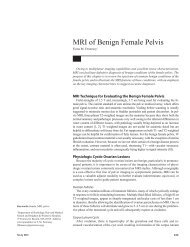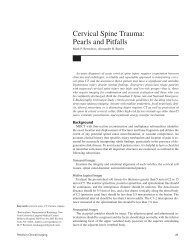Scientific Session 1 â Breast Imaging: Mammography
Scientific Session 1 â Breast Imaging: Mammography
Scientific Session 1 â Breast Imaging: Mammography
You also want an ePaper? Increase the reach of your titles
YUMPU automatically turns print PDFs into web optimized ePapers that Google loves.
<strong>Scientific</strong> <strong>Session</strong> 23—Gastrointestinal <strong>Imaging</strong>:Liver <strong>Imaging</strong>—Focal Disease and TechniqueThursdayand a hybrid strategy of ultrasound for all patients followed by MRI forthose patients who required surgery. Outcome probabilities and effectivenesswere derived from the literature or estimated by expert opinion.Costs were estimated from the societal perspective utilizing Medicarereimbursement. The standard society willingness to pay of $50,000 perquality adjusted life year was used.Results: At published accuracies, ultrasound alone was the most costeffectiveimaging strategy. The hybrid strategy of ultrasound followed bypreoperative MRI was more cost-effective than MRI alone. MRI alonewas preferred over the hybrid imaging strategy when the sensitivity of ultrasoundfor full-thickness tears fell below 89% or when the sensitivity forpartial-thickness tears fell below 50%. MRI alone was also preferred overthe hybrid imaging strategy when the specificity of ultrasound for all rotatorcuff tears fell below 60%. MRI alone was preferred over the hybrid imagingstrategy when the sensitivity of MRI for full thickness tears rose above 95%or when the sensitivity for partial thickness tears rose above 79%.Conclusion: Ultrasound followed by preoperative MRI is a cost-effectiveimaging strategy for rotator cuff tear evaluation. This strategy allows preoperativeanatomic definition and identification of alternative or concurrentdiagnoses.<strong>Scientific</strong> <strong>Session</strong> 23 —Gastrointestinal <strong>Imaging</strong>: Liver<strong>Imaging</strong>—Focal Disease andTechniqueThursday, May 5, 2011Abstracts 196-204196. Characteristics and Distinguishing Features of HepaticAdenoma and Focal Nodular Hyperplasia on GadoxetateDisodium–Enhanced MR <strong>Imaging</strong>Purysko, A.*; Remer, E.; Christopher, C.; Obuchowski, N.; Veniero, J.Cleveland Clinic, Cleveland, OHAddress correspondence to A. Purysko (purysko@gmail.com)Objective: To identify the imaging characteristics of hepatic adenoma(HA) and focal nodular hyperplasia (FNH) on gadoxetate disodium–enhancedMR images and assess distinguishing features.Materials and Methods: An institutional review board–approved databaseof 198 patients who underwent MRI using gadoxetate disodium wassearched; 25 patients, 16 with FNH and nine with HA were identified.Examinations were performed on 1.5-T or 3-T scanners. 0.025 mmol/kgbody weight gadoxetate disodium (Eovist, Bayer HealthCare) was administeredat 2 mL/s. The reference standard for HA was proof at biopsy;only one lesion per patient was utilized. The reference standard for FNHwas imaging features and clinical follow-up. Three readers retrospectivelyreviewed blinded, randomized images for lesion signal intensity comparedwith normal liver on T1-weighted, T2-weighted, and arterial, portal,late portal contrast-enhanced images. Presence of fat, capsule, centralscar, heterogeneity, and shape was determined. Diagnosis was made andconfidence level rated (1–5 scale). Hepatocyte phase was viewed anddiagnosis and confidence level was rated. Lesion and background liversignal intensity on all phases was measured, and signal ratio was calculated(lesion signal intensity contrast-enhanced - unenhanced / liversignal intensity contrast-enhanced - unenhanced ). Signed rank, Fisherexact, and Wilcoxon two-sample tests were used for analysis.Results: Correct diagnosis of HA ranged from 89% to 100% and FNHfrom 87.5% to 93.8% for readers using unenhanced and dynamic sequences.After a hepatocyte phase was added, two readers had an increasedpercentage of FNH correct (86–100%), but this was not statisticallysignificant (p = 1.0). There was no change for HA. Confidencescores significantly increased for one reader for HA (p = 0.008) and fortwo readers for FNH (p = 0.002–0.0001). Signal intensity on enhancedimages was higher for FNH than HA compared with background liver.Difference was greatest on the hepatocyte phase (p = 0.001–0.006).Lesion-to-liver signal ratio cut-off of 0.7 yielded 100% specificity and89% sensitivity for HA. Presence of central scar (56–81%) for FNH (p =0.001–0.008) and fat (33–78%) for HA (p = 0.001–0.037) were the onlystatistically significant morphologic features.Conclusion: Gadoxetate disodium–enhanced MRI had high accuracy inthe diagnosis of HA and FNH, with an increase in the confidence in FNHdiagnosis with hepatocyte phase. While HA may demonstrate enhancementduring the hepatocyte phase, in most cases it was inferior comparedwith liver parenchyma, and this characteristic can be used as an additionaldistinguishing feature between HA and FNH.197. Diffusion Weighted <strong>Imaging</strong> for Quantification of Hepatic IronDeposition in Patients With Thalassemia Major: Comparison WithMulti-Echo Gradient-Recalled Echo T2*-Weighted <strong>Imaging</strong>Restaino, G. 1 *; Occhionero, M. 1 ; Roiati, S. 2 ; Caulo, A. 2 ; Costanzo, S. 1 ;Missere, M. 2 ; Pepe, A. 3 ; Sallustio, G. 1 1. Catholic University “John PaulII” Research Center, Campobasso, Italy; 2. Catholic University “A.Gemelli” Hospital, Rome, Italy; 3. Fondazione G. Monasterio C.N.R.-Regione Toscana, Pisa, ItalyAddress correspondence to G. Restaino (gennares@hotmail.com)Objective: Liver iron overload affects many important conditions like hemochromatosis,thalassemia major, and chronic viral hepatitis. Multiecho gradient-recalledecho (GRE) MRI has been established in clinical practice as afeasible, accurate, and reproducible means for liver iron overload assessment.Diffusion weighted imaging (DWI) is very sensitive to susceptivity effects likethose caused by iron deposits. The purpose of the study was to determine thediagnostic performance of DWI, compared with multi-echo T2*-weighted imaging,for hepatic iron quantification in patients with thalassemia major.Materials and Methods: Fifty-three patients with thalassemia major(35.2 years of age; 27 female and 26 male) and 20 healthy volunteers(29.3 years of age; 10 female and 10 male) underwent liver MRI witha 1.5-T scanner. Liver T2* signal measurement was performed with amultiecho GRE sequence and a custom-written software (Hippo-MIOT,IFC CNR). Apparent diffusion coefficient (ADC) values were measuredin the same hepatic region with an echo-planar diffusion-weighted imaging(DWI) sequence with two different b values (600 and 1000) and adedicated software (Functool2, ADW 4.2,GEMS). The patients and thevolunteers were classified, according to their liver T2* signal, in four ironburden groups: I, no overload; II, borderline; III, slight; and IV, moderateA74*Will present paper
















